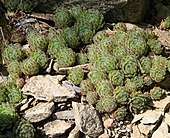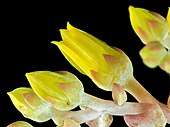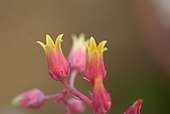Sempervivoideae
Sempervivoideae is the largest of three subfamilies in the Saxifragales family Crassulaceae, with about 20–30 genera with succulent leaves. Unlike the two smaller subfamilies, it is distributed in temperate climates.
| Sempervivoideae | |
|---|---|
.jpg) | |
| Sempervivum tectorum | |
| Scientific classification | |
| Kingdom: | Plantae |
| Clade: | Tracheophytes |
| Clade: | Angiosperms |
| Clade: | Eudicots |
| Order: | Saxifragales |
| Family: | Crassulaceae |
| Subfamily: | Sempervivoideae Arn[1] |
| Type genus | |
| Sempervivum | |
| Tribes | |
| |
| Synonyms | |
| |
Description
Succulent leaved plants. Unlike the other two smaller subfamilies, which are highly derived, Sempervivoideae retain the basic features of the family Crassulaceae.[3] The Sempervivoideae contain many familiar horticultural plants, such as Sedum.[4]
Taxonomy
Sempervivoideae has taxonomic priority over its synonym, Sedoideae,[5] and is related to the other Crassulaceae subfamilies, as shown in this cladogram;
| Cladogram of evolutionary lines in Crassulaceae[3] | |||||||||||||||
|
Subdivisions (tribes)
Six clades within Crassulaceaeare are segregated into the five tribes with about thirty genera.[3]
| Clade | Tribe |
|---|---|
| Acre | Sedeae |
| Leucosedum | |
| Aeonium | Aeonieae |
| Sempervivum | Semperviveae |
| Rhodiola | Umbiliceae |
| Hylotelephium | Telephieae |
The composition of the five tribes are: (number of genera/species);[6]
- Telephieae (6/50)
- Umbiliceae (4/100)
- Semperviveae (2/75)
- Aeonieae (3/70)
- Sedeae (7/520)
and their relationship is shown in the cladogram:
| Cladogram of Sempervivoideae tribes[3] | |||||||||||||||||||||||||||
|
However, given the difficulty of establishing a stable classification, some authors prefer larger groupings, e.g.;[7]
- Telephinae (Telephieae, Umbilicieae)
- Sedinae (Semperviveae, Aeonieae, Sedeae)
Semperviviae, Aeonieae and Sedeae are definable only by plesiomorphic features, with their genera all derived from within Sedum. Segregates of Sedum occur in each of these, but lack sufficient features to allow them to be allocated to definitive genera.[3][8]
Telephieae ('t Hart) Ohba and Thiede ined.The Telephieae[lower-alpha 2] genera consist of former infrageneric taxa of Sedum, and are distributed primarily in East Asia. Defined by 5-merous flowers, free petals, flat, dentate leaves and tuberous roots or thickened rhizomes. Leaves usually in rosettes, except Hylotelephium, petals often spotted, autumn flowering. The taxonomy remains unstable, with species Orostachys embedded within both Meterostachys and Hylotelephium. It contains about 6 genera, with 50 species, including:[5][3] It is likely that diversification of the tribe occurred at the time of the formation of the Himalayas.[9]
| |
Umbiliceae Meisn.The Umbeliceae occur mainly in temperate areas of Asia, flowering in spring to early summer, with about 4−5 genera and 100 species. Aizopsis is included by some authors in Phedimus. The genera are among those that have been segregated from Sedum, including:[3] | |
Semperviveae Dumort.Semperviveae have acuminate leaves and polymerous flowers. Two to three genera, derived from within Sedum, c. 275 species. Earlier treatments considered Jovibarba a section of Sempervivum[3] but has subsequently been demonstrated to be a separate genus.[4]
| |
Aeonieae Thiede ined.[lower-alpha 1]Aeonieae (also referred to as the GAMA clade, for Greenovia, Aeonium, Monanthes and Aichryson),[14] whose distribution is primarily Macaronesia, have polymerous flowers, and include genera derived from within Sedum, with about 3 genera and 70 species, including:[3] | |
Sedeae Fr.Sedeae is the largest of these and contains two sister clades, Leucosedum and Acre.[3] It contains about 12 genera, mainly derived from within Sedum, and 520 species. Genera are often treated as two separate clades. Of these, while the larger Acre is robust, Leucosedum remains paraphyletic.[6] The genera included are:[3] | |
Leucosedum cladeGenera derived from European and Mediterranean Sedum subg. Gormania, with two western North American genera (Dudleya, Sedella, which are sister genera).[6]
| |
Acre cladec. 7 genera, 500 sp.
|
Genera
Given the monophyly demonstrated for Aeonieae and Semperviveae (as quite distinct from Sedeae), it has been recommended that those species of Sedum originally found in those tribes, be removed from the genus and reassigned. This includes Sedum series Rupestria from Semperviveae, but collectively account for only a small fraction of the genus. While restricting Sedum to Sedeae simplifies the infrafamilial structure of the genus, its species remain distributed within both clades of this tribe.[6][13][15]
Notes
- Reveal proposed the revised authority: Aeonieae Thiede ex Reveal[2]
- The name Telephieae may be illegitimate in this context, since it has been previously used as a synonym for Caryophyllaceae[2]
- Petrosedum is classified as Sedum series Rupestria by some authors[6]
References
Bibliography
Books
- Eggli, Urs, ed. (2003). Illustrated Handbook of Succulent Plants: Crassulaceae. Springer Science & Business Media. doi:10.1007/978-3-642-55874-0. ISBN 978-3-642-55874-0.
- Thiede, J; Eggli, U (2007). "Crassulaceae". In Kubitzki, Klaus (ed.). Berberidopsidales, Buxales, Crossosomatales, Fabales p.p., Geraniales, Gunnerales, Myrtales p.p., Proteales, Saxifragales, Vitales, Zygophyllales, Clusiaceae Alliance, Passifloraceae Alliance, Dilleniaceae, Huaceae, Picramniaceae, Sabiaceae. pp. 83–119. ISBN 978-3540322146. (full text at Research Gate)
Articles
- Carrillo-Reyes, Pablo; Sosa, Victoria; Mort, Mark E. (October 2009). "Molecular phylogeny of the Acre clade (Crassulaceae): Dealing with the lack of definitions for Echeveria and Sedum" (PDF). Molecular Phylogenetics and Evolution. 53 (1): 267–276. doi:10.1016/j.ympev.2009.05.022. PMID 19482091.
- Gallo, Lorenzo (24 August 2017a). "Towards a review of the genus Petrosedum (Crassulaceae): Taxonomic and nomenclatural notes on Iberian taxa". Webbia. 72 (2): 207–216. doi:10.1080/00837792.2017.1363978.
- Gallo, Lorenzo (9 May 2017). "Nomenclatural novelties in Petrosedum (Crassulaceae)". Phytotaxa. 306 (2): 169. doi:10.11646/phytotaxa.306.2.8.
- Gontcharova, S. B.; Artyukova, E. V.; Gontcharov, A. A. (June 2006). "Phylogenetic relationships among members of the subfamily Sedoideae (Crassulaceae) inferred from the ITS region sequences of nuclear rDNA" (PDF). Russian Journal of Genetics. 42 (6): 654–661. doi:10.1134/S102279540606010X.
- Gontcharova, Svetlana B.; Gontcharov, Andrey A. (2007). "Molecular Phylogenetics of Crassulaceae" (PDF). Genes, Genomes and Genomics. 1 (1): 40–46.
- Gontcharova, S. B.; Gontcharov, A. A. (11 October 2009). "Molecular phylogeny and systematics of flowering plants of the family Crassulaceae DC". Molecular Biology. 43 (5): 794–803. doi:10.1134/S0026893309050112.
- Grulich, Vit (1984). "Generic division of Sedoideae in Europe and the adjacent regions" (PDF). Preslia. 56: 29–45.
- Hart, H. 't (1995). "The evolution of the Sedum acre group (Crassulaceae)" (PDF). Bocconea. 5: 119–128.
- Lim, Mi Sang; Choi, Sun Hee (2018). "Estimation of Phylogeny of Nineteen Sedoideae Species Cultivated in Korea Inferred from Chloroplast DNA Analysis". The Horticulture Journal. 87 (1): 132–139. doi:10.2503/hortj.OKD-087.
- Mayuzumi, Shinzo; Ohba, Hideaki (2004). "The Phylogenetic Position of Eastern Asian Sedoideae (Crassulaceae) Inferred from Chloroplast and Nuclear DNA Sequences". Systematic Botany. 29 (3): 587–598. doi:10.1600/0363644041744329. ISSN 0363-6445. JSTOR 25063994.
- Mort, Mark E; O'Leary, T. Ryan; Carrillo-Reyes, Pablo; et al. (December 2010). "Phylogeny and evolution of Crassulaceae: Past, present, and future". Biodiversity & Ecology. 3: 69–86.
- Nikulin, Arthur; Vyacheslav Nikulin, Vyacheslav; Gontcharov, Andrey (October 2015). "To the question of phylogenetic structure of the tribe Telephieae (Sempervivoideae, Crassulaceae) based on ITS rDNA sequence comparisons". Botanicheskii Zhurnal (in Russian). 100 (10): 1030–1040.
- Nikulin, Vyacheslav Yu.; Gontcharova, Svetlana B.; Stephenson, Ray; Gontcharov, Andrey A. (September 2016). "Phylogenetic relationships between Sedum L. and related genera (Crassulaceae) based on ITS rDNA sequence comparisons". Flora. 224: 218–229. doi:10.1016/j.flora.2016.08.003.
- Ohba, Hideaki; Bartholomew, Bruce M; Turland, Nicholas J; Kunjun, Fu (2000). "New Combinations in Phedimus (Crassulaceae)". Novon. 10 (4): 400–402. doi:10.2307/3392995. JSTOR 3392995.
- Ohba, H (1978). "Generic and infrageneric classification of the old world sedoideae crassulaceae". Journal of the Faculty of Science University of Tokyo Section III Botany 12(4): 139-193. 12 (4): 139–193.
- Reveal, James L (2012). "An outline of a classification scheme for extant flowering plants" (PDF). Phytoneuron. 37: 1–221.
- Soltis, D. E.; Mort, M. E.; Latvis, M.; Mavrodiev, E. V.; O'Meara, B. C.; Soltis, P. S.; Burleigh, J. G.; Rubio de Casas, R. (29 April 2013). "Phylogenetic relationships and character evolution analysis of Saxifragales using a supermatrix approach". American Journal of Botany. 100 (5): 916–929. doi:10.3732/ajb.1300044. PMID 23629845.
Websites
- "International Crassulaceae Network". Retrieved 5 September 2019.
- Fu, Kunjun; Ohba, Hideaki; Gilbert, Michael G. (2004). "Crassulaceae Candolle". p. 202. Retrieved 24 August 2019., in Flora of China online vol. 8
External links
| Wikimedia Commons has media related to Sempervivoideae. |
| Wikispecies has information related to Sempervivoideae |
.jpg)

_(Marianne_Perdomo)_1.jpg)

